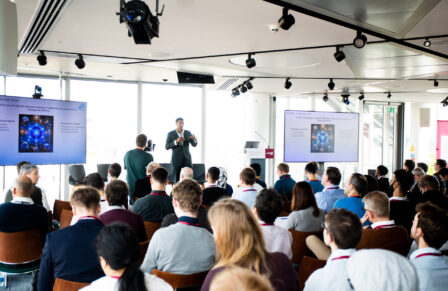Seven steps to ensure your organisation is ready for quantum computing
Posted 5 May 2022
Most experts agree that quantum computing has the potential to outperform classical computers in a few years for some use cases. Also, there is a risk that in the future quantum computers will be used to crack encryption that is currently safe. This risk needs to be mitigated. This blog describes a journey you should start now to make your organisation ready for quantum computing.
1. Ensure your encryption is quantum proof
Shor’s 1994 quantum factorization algorithm suggested an impressive “quantum speed-up” that could undermine Rivest–Shamir–Adleman (RSA) encryption widely used in web communication channels. Although the large, universal, fault tolerant computers needed to run the full algorithm are probably decades away, there are hints that a variation of this algorithm might break RSA encryption much sooner. For example, the integer 291,311 was recently factorised using a digital simulation of Variational Quantum Factoring. Experts suggest that Diffie-Hellman (DH) and Elliptic Curve-based encryption is also at risk.
Any industry that depends on RSA or similar schemes to protect business secrets on electronic documents should beware of “store now, break later” attacks. Also, the combined development and lifespan of Internet of Things devices (IoT) devices, like modern cars, can be very long, and if an RSA encryption algorithm is hardwired in the chip there is risk that devices could still be in the field when quantum computers arrive that can break the encryption. This is also likely to be highly relevant to telecoms, because SIM cards, and eSIM, provide hardware decryption. There is a strong case for implementing so-called “quantum-proof” encryption algorithms in both software and hardware.
2. Get organised
Quantum computing has a fundamentally different computer paradigm from classical computing because parallel processing over many qubits in superposition is possible, whereas classical computers process instructions sequentially. However, this does not mean that learnings from earlier IT projects, perhaps including implementations of Enterprise Resource Planning (ERP), or Customer Relationship Management (CRM) systems should be forgotten or ignored.
The first step must be to gain executive-level sponsorship, ensuring appropriate buy-in at senior level, and avoiding turf wars. Duplication of work across a series of functional silos is unlikely to be optimal. The quantum journey is a voyage of discovery, with few reliable sign posts, and your executive sponsor will need clear thinking to separate the hype from the opportunity, as well as courage, vision and pragmatism. You will need to agree with your sponsor where quantum computing will fit into your organisation, and put in place appropriate governance. An IT-led initiative may be too narrowly focused, particularly if subject matter experts and non-IT users are not represented. We recommend setting up an initial high-level steering group with representation across the organisation, complemented by a smaller working group. Also, there needs to be funding in place to cover the initial exploration and discovery phases.
3. Explore quantum computing
There are various quantum conferences that give a good overview of the state of the art of quantum computing, training is provided by quantum companies, such as D-Wave, Microsoft and IBM, and there are remote learning courses available; NQCC and Bristol University have developed two six-week online courses on Quantum Information and Quantum Computing, aimed at those wanting to move into the field of quantum technologies.
As well as understanding the theory of quantum computing it is important to consolidate this knowledge on real, or simulated, quantum devices. Fortunately there are a number of options to gain access to quantum computers either for free, or relatively cheaply including, but not limited to Python based packages like Qiskit, which can be used to set up quantum circuits on real IBM and IonQ quantum computers, cloud vendors like Amazon Braket and Microsoft Azure, and direct access, for example, to the D-Wave quantum computers. Be careful, though, to avoid becoming tied to one vendor or to proprietary software.
It is important to have a long term procurement plan. Access to quantum computing is not expensive today, because the development of business cases with an audited return on investment is at an early stage, however, in the future access to leading edge devices may become much more expensive.
It is worth exploring if you can gain partial government funding for your project, maybe through future Innovate UK Collaborative Research and Development challenges.
Although we recommend developing an internal quantum proficiency, don’t be afraid to take external advice from organisations like Digital Catapult. Also, make sure also that you include experts in fields other than quantum in the team.
4. Discover potential use cases
We are in the Noisy Intermediate Scale Quantum (NISQ) computing age, where quantum computers have tens of qubits, and are prone to error. Only a few use cases are likely to give any benefit over classical computers in the next few years. Viable short term use cases may involve optimization, quantum simulation of physical systems and quantum machine learning. It is important to note that there has been a recent explosion in the development of algorithms and no one really understands yet where quantum computing will be used in the future.
There are many papers, reports and white papers available to study online. Workshops and conferences may feature case studies, and quantum computing vendor websites often have good examples. Specific expertise may be needed to map your business use cases to specific algorithms, and identify appropriate quantum software and hardware to run these on.
5. Define the project
The best, and often the only way, to find out if a use case is likely to deliver future business benefits is to set up a realistic example on a quantum computer. Once you have selected a potential use case you will need to shape a project to take this use case forward, select a team, gain funding, and make a go/no go decision. One possible outcome of this stage may be a decision to put the work on hold, if the quantum computing technology is not yet robust enough to support your use case.
6. Design
You will need to carefully design your proof of concept. In IT, shorter cycles are often better than longer, so start with a toy example and then add scale and complexity. The quantum algorithm may need a large, complicated circuit which may drive the need for specialised quantum software to scale. The quantum computer may also need to be integrated with existing IT assets, for example, data may need to be extracted and loaded into the quantum computer, and the results of the computation may need to be fed to other systems, so it is important to design a high level technology architecture, which should consider scalability and integration.
7. Build a proof of concept
The aim of the proof of concept, which should be on a real quantum computer, is to understand if the use case makes financial sense, and, if it does, to develop a plan to scale to production, including change management, training, dataload and finalisation of the technology architecture. If possible the algorithm should be run using different quantum computing models, such as quantum annealing, the circuit model, and maybe photonic quantum computers, to find out which works best for your problem.
The proof of concept will give you more understanding of quantum algorithms, and it is important to consider any new use cases which may have been found during the project.
To conclude…
Few could have predicted how modern computing would change our world. In due course quantum computing will almost certainly change the world again. Now is the time to ensure your organisation is ready for the future. When you have completed these seven steps you can be confident that you won’t get any nasty surprises from quantum decryption, and you will have gained an understanding of some potential quantum computing use cases for your organisation, and may be ready to move to scale and ultimately commercialisation.
Many thanks to Mustafa Rampuri, Director Quantum Technologies Innovation Centre, University of Bristol for valuable input.










